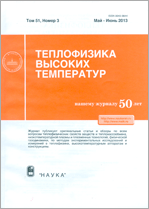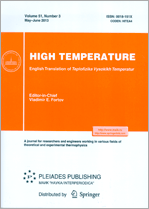|
This article is cited in 3 scientific papers (total in 3 papers)
Heat and Mass Transfer and Physical Gasdynamics
Influence of the melt thermal conductivity on temperature fields in aluminum oxide upon heating by concentrated laser radiation
V. K. Bityukov, V. A. Petrov, I. V. Smirnov
Moscow State Institute of Radio-Engineering, Electronics and Automation (Technical University)
Abstract:
The influence of the melt thermal conductivity $\Lambda_{\rm m}$ on the formation of temperature fields upon heating and melting of a plane aluminum oxide layer by $\rm CO_2$ laser radiation with a flux density $q$ from $200$ to $3000$ W/cm$^2$ has been investigated using a rigorous model of transient combined radiative and conductive energy transfer. The maximum heating time is $100$ s. Parameter $\Lambda_{\rm m}$ varies from $1.5$ to $3$ W/(m K). Absorption coefficient for the laser radiation is assumed to be $1000$ cm$^{-1}$. The formation of a two-phase region, which exists for a short time, has been observed in the initial melting stage at a depth less than the penetration depth of the heating laser radiation. Maxima of the heated-surface temperature and melt thickness (not coinciding in time) are found at $q > 600$ W/cm$^2$. The melt thickness and its value at the maximum depend only slightly on q, while parameter $\Lambda_{\rm m}$ significantly affects the melt thickness at the maximum and during the entire heating process. It is shown that similar temperature profiles are established in the solid phase at different $\Lambda_{\rm m}$ values while approaching the quasi-steady state due to large values of the melt absorption coefficient in the wavelength range that is most energetically important for radiative transfer. The melt thermal conductivity affects only slightly the temperature of the “cold” surface that is opposite the melt.
Received: 27.02.2015
Accepted: 22.12.2015
Citation:
V. K. Bityukov, V. A. Petrov, I. V. Smirnov, “Influence of the melt thermal conductivity on temperature fields in aluminum oxide upon heating by concentrated laser radiation”, TVT, 55:2 (2017), 240–246; High Temperature, 55:2 (2017), 233–238
Linking options:
https://www.mathnet.ru/eng/tvt7875 https://www.mathnet.ru/eng/tvt/v55/i2/p240
|


| Statistics & downloads: |
| Abstract page: | 268 | | Full-text PDF : | 171 | | References: | 50 | | First page: | 4 |
|





 Contact us:
Contact us: Terms of Use
Terms of Use
 Registration to the website
Registration to the website Logotypes
Logotypes








 Citation in format
Citation in format 
